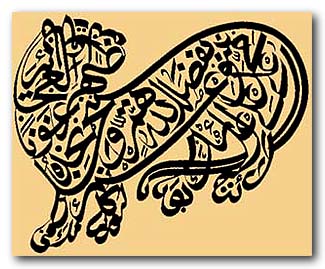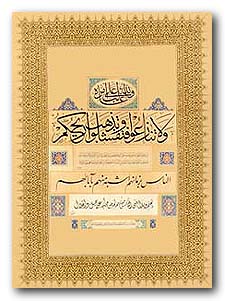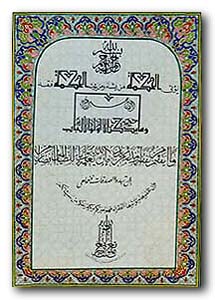|







Art of Arabic Calligraphy
Arabic calligraphy is a genuine Islamic and Arabic art. It is, no doubt,
the most important element of the Arabic legacy, as it is the pot wherein all
Arab cultures, over succeeding generations, are merging to come up with such
eternal heritage.
Its forms, however, differ, as Arabic calligraphy has surpassed the end of
writing process itself to reach eternity in terms of design and styles; further
becoming one of the outstanding features of Islamic arts, constituting the
common denominator for all Arab and Islamic arts, either they were taking shapes
of fixed buildings or mobile antiques. It was, also, used in photographing and
mosques decorating, as there is not one Arab monument void of Arabic calligraphy
art tang.
| |
History
Arabic calligraphy evolving
 Theories
that fathom the evolving of Arabic calligraphy are too many. Yet, the origin of
Arabic calligraphy and its history are still not definite. Researchers, however,
have realized that the Arabs, in old times, were not knowledgeable of
calligraphy until they interacted with urbanities who considered calligraphy of
social necessity. This happened as Arabs resided the remote areas surrounding
the Arab Peninsula. When the Roman Empire got weaker Arabs' position improved,
as they settled in the south of Hegaz (Saudi Arabia) and Aqaba Gulf. They had
geographical and political entity, the most important among that was a kingdom
known as AlNabat in Jordan. Theories
that fathom the evolving of Arabic calligraphy are too many. Yet, the origin of
Arabic calligraphy and its history are still not definite. Researchers, however,
have realized that the Arabs, in old times, were not knowledgeable of
calligraphy until they interacted with urbanities who considered calligraphy of
social necessity. This happened as Arabs resided the remote areas surrounding
the Arab Peninsula. When the Roman Empire got weaker Arabs' position improved,
as they settled in the south of Hegaz (Saudi Arabia) and Aqaba Gulf. They had
geographical and political entity, the most important among that was a kingdom
known as AlNabat in Jordan.
Arabs, then, derived one of Aramic calligraphies using
it but keeping their own Arabic language. So, it became clear that Arabic
calligraphy has undergone three phases: First, Aramic calligraphy which tends to
squaring. Second, Napty calligraphy, and then came the stage of maturity with
the presence of Arabic letters which tend to take circular shapes.
Arabic calligraphy developing did not stop at this
limit, but it was further enhanced. At the very outset, letters had no dots but
during Abbasside era, dots and punctuation marks were developed, as Arabic
calligraphy was spread when Islam prevailed simply because it became the main
instrument of the Islamic religion. Learning Arabic be, came quite related to
religious aspect, the matter which finally led to its speedy outspread as a
language.
 Arabic
calligraphy converted to decoration, as Arab kings and rulers favored writers
who gained wide reputation and vast fame. Let alone, they, also, were poured by
money to encourage them. Arabic
calligraphy converted to decoration, as Arab kings and rulers favored writers
who gained wide reputation and vast fame. Let alone, they, also, were poured by
money to encourage them.
Accordingly, Arabic calligraphy became the common
grounds for developing both Arabic and Islamic arts.
Arabs have mastered making ink of natural substances,
as they used seeds of yam and glue. The black color was preferred but there were
other colors: red, blue, green, brown, purple and ruby. Sometimes, fragrances
were to be added to give ink good smell.
Difference between art & writing

There emerged a difference between the process of writing itself and the art
of writing, as the first is the way of conveying ideas and the second is the
medium for feelings, emotions and sentiments. The art of Arabic calligraphy,
anyway, was developed over ages to become spiritual engineering by means of a
writing tool. History & origin
Calligraphy, as a matter of fact, was and will remain playing fundamental
role in the history of mankind, as it is a key tool of establishing
communication among peoples; conveying and preserving human heritage along with
its experiences over times and maintaining civilizations from generation to
another.
The need for writing and codifying has emerged with the dawn of the history,
as such was phased in through five stages:
1.Picture writing stage; or expressing ideas through pictures.
2. Symbolic stage ; or expressing sense via symbolic pictures.
3. Syllabic stage in which the picture implied sound.
4. Phonetic stage that used pictures of things composed of the first alphabet
of a picture's indication and letter.
5. Alphabetical stage which had new marks similar to vertical and horizontal
screws.
Chinese, Hittities and Hieroglyphic are the oldest calligraphies
on Earth which, up till now are still a mystery.
   
Art of calligraphy and its development
As Muslim Arab artists, at the outset, declined to
sculpture and pencil live pictures, taking the trend of developing pottery art
with oriented decoration tange, Arabic calligraphy has for this reason improved
to a great measure. Arab artists had to unleash their artistic and creative
potentials through different means, using Arabic calligraphy as a rich and easy
way to create new aspects of art.
Arabic calligraphy reached its peak in the Abbasside
preferred but there were other colors: red, blue, green, brown, purple and ruby.
Sometimes, fragrances were to be added to give ink good smell.
 Calligraphy
substances took the form of boards, stones, pottery and leather, but at the very
end of the Omiade State 133 AH and at the outset of Abbasside State, great
revolution was made in calligraphy material when Arabs discovered the way of
making papers in Samarkand, Central Asia, as paper making which had been secret
was circulated to reach Baghadad and then Damascus, prevailing all Arab States
and spreading to Europe as well. Calligraphy
substances took the form of boards, stones, pottery and leather, but at the very
end of the Omiade State 133 AH and at the outset of Abbasside State, great
revolution was made in calligraphy material when Arabs discovered the way of
making papers in Samarkand, Central Asia, as paper making which had been secret
was circulated to reach Baghadad and then Damascus, prevailing all Arab States
and spreading to Europe as well.
AlFostat, the first Islamic and Egyptian capital city,
was famous as one calligraphy improving center. Ibn Tollon Mosque harbors unique
models of terrific masterpieces, among which the simple Cofi calligraphy.
Baghdad getting weak following the Tatar invasion,
Arabic calligraphy was completely conveyed to Egypt. The Fatimid State's people
inclined to luxury, decoration and beautification. Also the outstanding writers,
in such age, were of Egypt.
They, further, mastered the Fatimid Cofi calligraphy,
and the Egyptian school was the most celebrated among other schools of
calligraphy as it overdid its opposite numbers in developing that art. Schools
of calligraphy in Egypt remained abounding in vast experiences until the era,
and outspread in north Africa, due to the Arab advent to Egypt in 641 AD when
Egypt nursed that kind of art and fostered it, till the calligraphy of Hegaz was
converted and oriented to Arabic calligraphy.
Artists of Syria moved to Egypt and with them the
secrets of mastering Cofi calligraphy. With the advent of the Ottoman State in
1517 AD, Arabic calligraphy art moved to Istanbul which became its center of
improving and developing, as Turkey adopted Latin letters in writing.
Arabic calligraphy has thrived once again in Egypt and
Arab countries to revive potentialities of artists who mastered such art and
developed it. affected by philosophy and drawing. Drawing man and animal became
motifs of Islamic decoration which depended on calligraphy, for this reason this
kind of art could be deemed as surface calligraphy.
Since the 8th century, Arabic calligraphy left, in
Europe, an impact reflecting decoration element, due to the direct interaction
with Islamic civilization, especially in Italy, Spain and France. Kings, at that
time, used Arabic calligraphy in their writings and messages.
|
![]()